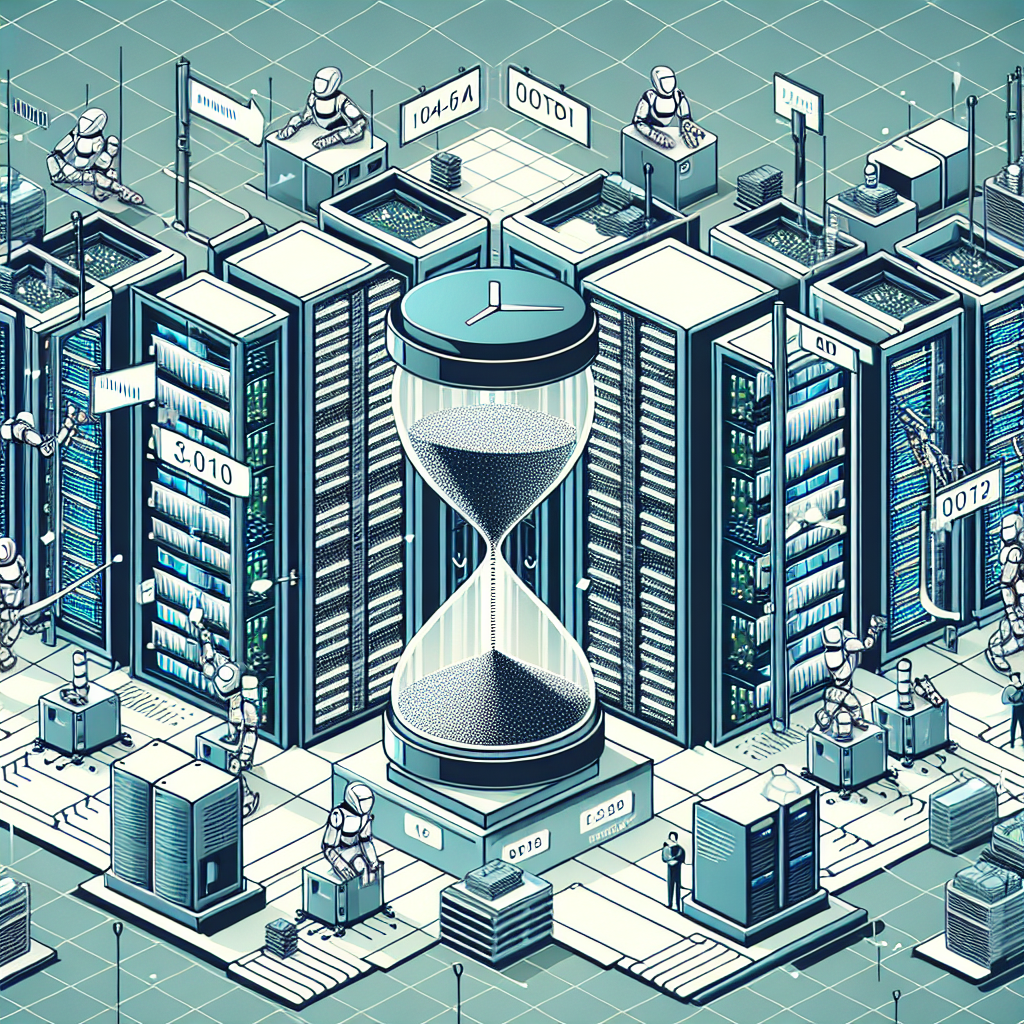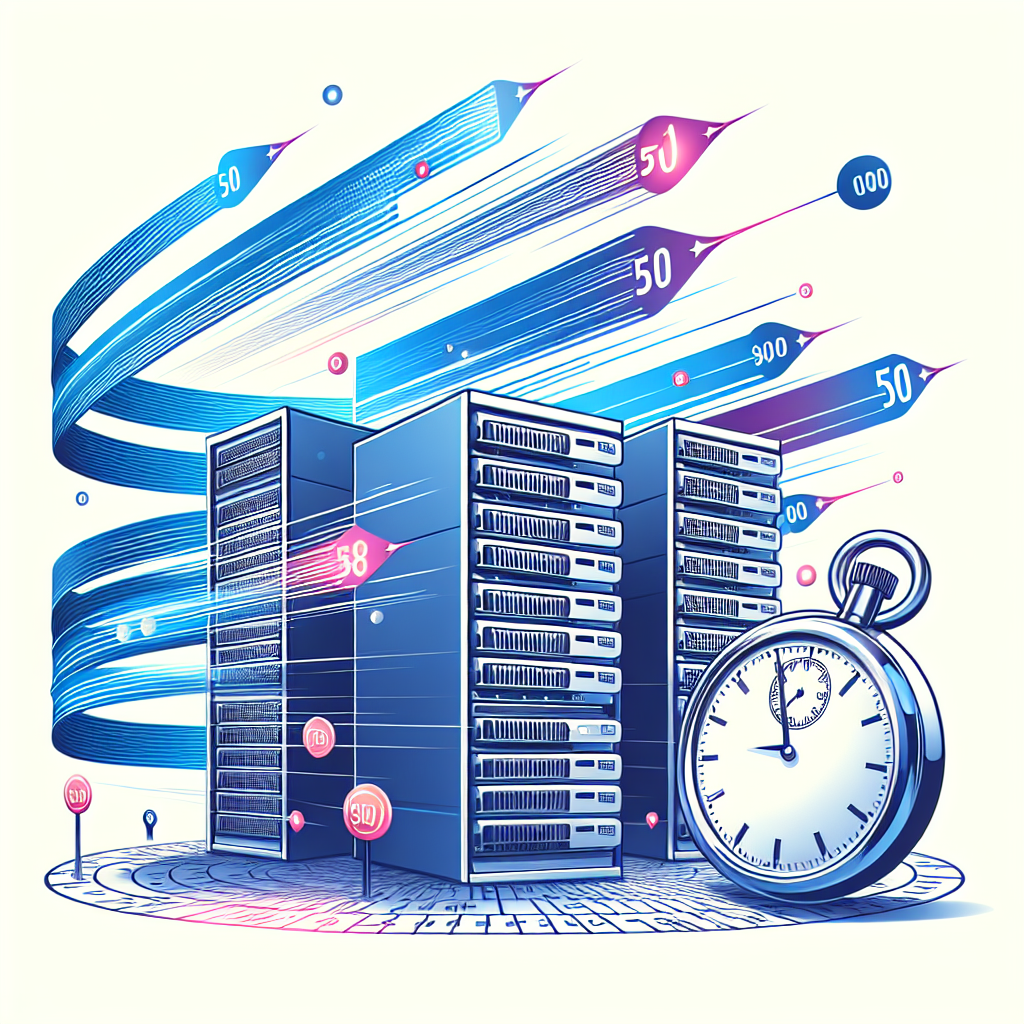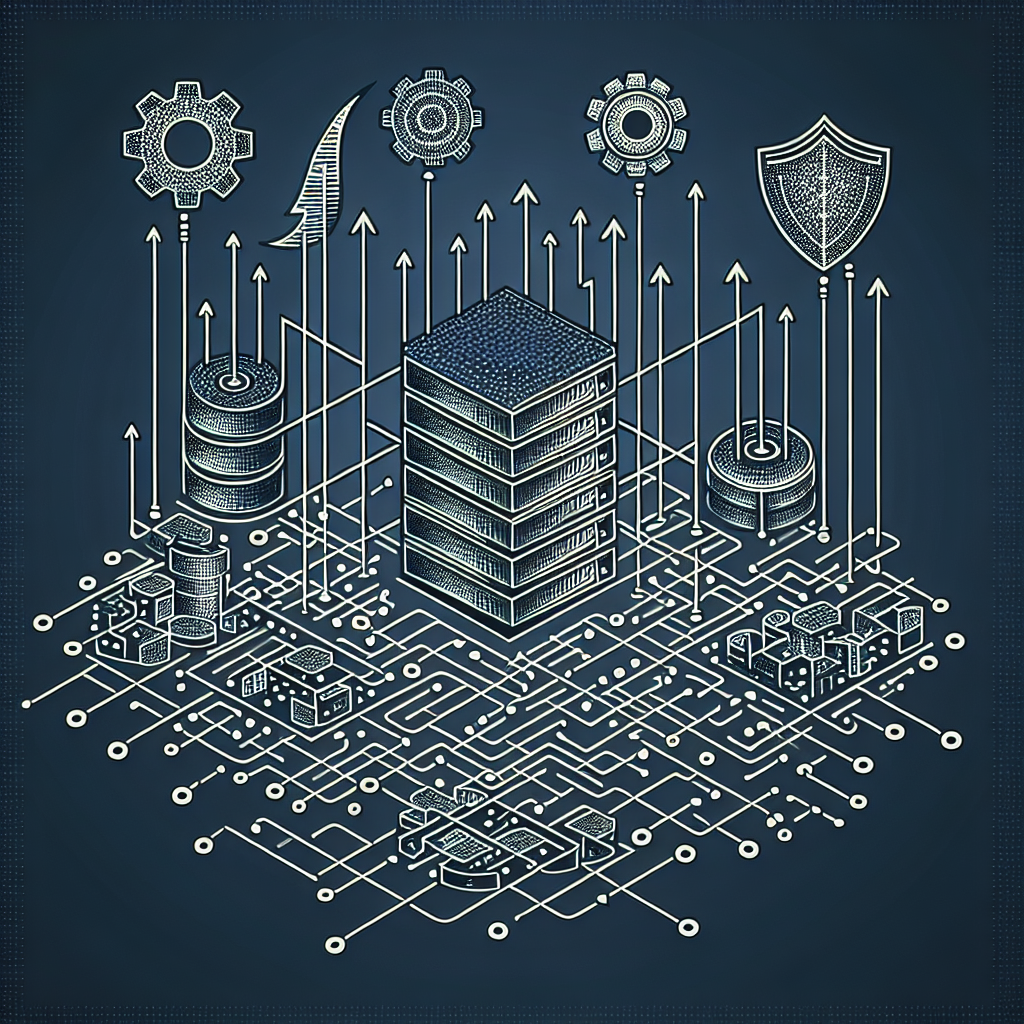Your cart is currently empty!
Tag: Reducing

The Role of Automation in Reducing Data Center MTTR
In today’s fast-paced world of technology, data centers play a crucial role in storing and managing vast amounts of data. With the increasing complexity and scale of data centers, the need for efficient and effective maintenance and troubleshooting processes has become more important than ever. Mean Time to Repair (MTTR) is a key metric that measures the average time it takes to repair a failed system or component in a data center. Reducing MTTR is essential for ensuring the smooth operation of data centers and minimizing downtime.One of the most effective ways to reduce MTTR in data centers is through automation. Automation refers to the use of technology to perform tasks without human intervention. By automating routine maintenance and troubleshooting processes, data center operators can significantly reduce the time it takes to identify and resolve issues, thus improving overall MTTR.
Automation can help reduce MTTR in data centers in several ways. Firstly, automation can streamline the monitoring and alerting process by automatically detecting and reporting issues in real-time. By continuously monitoring the performance of data center systems and components, automation can quickly identify potential problems before they escalate into major failures, allowing operators to take proactive measures to resolve them.
Secondly, automation can facilitate rapid troubleshooting by providing operators with detailed diagnostic information and recommended actions to resolve issues. With automated tools and workflows in place, operators can quickly identify the root cause of a problem and implement the necessary fixes without the need for manual intervention, thereby reducing MTTR.
Furthermore, automation can help improve the efficiency of maintenance tasks by automating routine procedures such as software updates, backups, and system reboots. By automating these tasks, data center operators can free up valuable time and resources to focus on more critical issues, leading to faster resolution times and reduced MTTR.
In conclusion, automation plays a crucial role in reducing MTTR in data centers by streamlining monitoring and alerting processes, facilitating rapid troubleshooting, and improving the efficiency of maintenance tasks. By leveraging automation technologies, data center operators can enhance the reliability and performance of their data centers, minimize downtime, and ultimately deliver a better experience for their customers. As data centers continue to evolve and grow in complexity, automation will become increasingly essential in ensuring the smooth operation and optimal performance of these critical facilities.

Reducing Seek Time: Strategies for Faster Data Access
Reducing seek time is a crucial aspect of improving the speed and efficiency of data access in computing systems. Seek time refers to the amount of time it takes for a storage device to locate and retrieve data from a specific location. The faster the seek time, the quicker the data can be accessed, leading to improved performance and overall user experience.There are several strategies that can be implemented to reduce seek time and enhance data access speed:
1. Implementing Solid-State Drives (SSDs): SSDs have significantly faster seek times compared to traditional hard disk drives (HDDs). By replacing HDDs with SSDs in a computing system, seek time can be greatly reduced, leading to faster data access and improved performance.
2. Data Partitioning: Partitioning data into smaller segments can help reduce seek time by allowing the system to quickly locate and retrieve specific data points. By organizing data into separate partitions based on their access patterns, the system can access data more efficiently, reducing seek time.
3. Caching: Caching frequently accessed data in a high-speed memory buffer can help reduce seek time by allowing the system to quickly retrieve data without having to access the storage device every time. By storing commonly accessed data in cache memory, the system can access data faster, leading to reduced seek time and improved performance.
4. Defragmentation: Fragmented data can increase seek time as the system has to search for scattered data points across the storage device. Performing regular defragmentation can help organize data in a more contiguous manner, reducing seek time and improving data access speed.
5. Optimizing File Systems: Optimizing file systems for faster data access can also help reduce seek time. By using file systems that are designed for quick data retrieval and access, such as NTFS or ext4, seek time can be minimized, leading to improved performance.
6. Using RAID Arrays: RAID arrays can help improve data access speed by spreading data across multiple drives, allowing for parallel access to data and reducing seek time. By combining multiple drives in a RAID configuration, seek time can be minimized, leading to faster data access.
In conclusion, reducing seek time is essential for improving data access speed and overall system performance. By implementing strategies such as using SSDs, data partitioning, caching, defragmentation, optimizing file systems, and using RAID arrays, seek time can be minimized, leading to faster data access and enhanced user experience. By optimizing data access speed, computing systems can operate more efficiently and effectively, meeting the demands of modern computing environments.

Reducing Latency: Strategies for Faster Data Transfer
In today’s fast-paced digital world, reducing latency is crucial for ensuring smooth and efficient data transfer. Latency refers to the delay between the time data is sent and received, and it can have a significant impact on the speed and performance of your network.There are several strategies you can implement to reduce latency and improve data transfer speeds. One of the most effective ways to decrease latency is to optimize your network infrastructure. This includes upgrading your hardware, such as routers and switches, to ensure they can handle the volume of data being transferred. Additionally, optimizing your network configuration and reducing the number of network hops can help minimize latency.
Another strategy for reducing latency is to use content delivery networks (CDNs). CDNs are a network of servers located in different geographic locations that cache and deliver content to users based on their location. By using a CDN, you can reduce the distance data has to travel, which can significantly decrease latency.
Implementing quality of service (QoS) protocols can also help reduce latency by prioritizing certain types of traffic over others. By prioritizing time-sensitive data, such as video streaming or voice calls, you can ensure a smoother and more consistent data transfer experience.
In addition to optimizing your network infrastructure and using CDNs and QoS protocols, you can also reduce latency by using compression techniques to reduce the size of data packets being transferred. By compressing data, you can decrease the amount of time it takes for data to be sent and received, ultimately improving data transfer speeds.
Overall, reducing latency is essential for ensuring fast and efficient data transfer. By optimizing your network infrastructure, using CDNs, implementing QoS protocols, and using compression techniques, you can minimize latency and improve the speed and performance of your network. By taking these steps, you can ensure a seamless and reliable data transfer experience for your users.

Reducing Environmental Impact: The Benefits of Sustainable Data Centers
In today’s digital age, data centers play a crucial role in storing, processing, and managing vast amounts of information. However, the environmental impact of data centers has come under scrutiny in recent years, with concerns about their energy consumption and carbon footprint. In response to these concerns, many companies are now turning to sustainable practices to reduce their environmental impact.Sustainable data centers are designed to minimize their energy consumption and carbon emissions while still meeting the high-performance demands of modern businesses. By incorporating energy-efficient technologies, such as cooling systems, servers, and power distribution units, sustainable data centers can significantly reduce their energy consumption and carbon footprint.
One of the key benefits of sustainable data centers is their ability to lower operating costs. By using energy-efficient technologies and practices, companies can reduce their electricity bills and minimize their overall energy consumption. Additionally, sustainable data centers can also benefit from tax incentives and rebates offered by governments for implementing green initiatives.
In addition to cost savings, sustainable data centers also offer environmental benefits. By reducing their energy consumption and carbon emissions, companies can help mitigate the impact of climate change and preserve natural resources. Sustainable data centers also help reduce air and water pollution, as well as waste generation, which can have a positive impact on local communities and ecosystems.
Furthermore, sustainable data centers can also enhance a company’s reputation and attract environmentally conscious customers and investors. By demonstrating a commitment to sustainability, companies can differentiate themselves in the marketplace and build trust with stakeholders. Sustainable data centers can also help companies comply with environmental regulations and meet sustainability goals set by governments and industry organizations.
Overall, the benefits of sustainable data centers are clear. By reducing their environmental impact, companies can lower operating costs, minimize their carbon footprint, and enhance their reputation. As the demand for data storage and processing continues to grow, it is crucial for companies to adopt sustainable practices in their data centers to ensure a more sustainable future for generations to come.

Strategies for Reducing Latency in Network Connections
In today’s fast-paced digital world, latency in network connections can be a major hindrance to productivity and efficiency. Latency is the delay in data transmission between devices on a network, and it can be caused by a variety of factors such as network congestion, distance between devices, and the quality of the network infrastructure. Fortunately, there are several strategies that can be implemented to reduce latency and improve network performance.One of the most effective ways to reduce latency in network connections is to optimize the network infrastructure. This can involve upgrading network hardware, such as routers and switches, to newer and faster models that are capable of handling higher data speeds. It can also involve optimizing network configurations to prioritize traffic and reduce congestion. By ensuring that the network infrastructure is up to date and properly configured, organizations can significantly reduce latency and improve network performance.
Another strategy for reducing latency in network connections is to implement Quality of Service (QoS) policies. QoS policies allow organizations to prioritize certain types of network traffic, such as VoIP calls or video streaming, over others. By giving priority to critical traffic, organizations can ensure that important data is delivered in a timely manner, reducing latency and improving overall network performance.
In addition to optimizing network infrastructure and implementing QoS policies, organizations can also reduce latency by using content delivery networks (CDNs). CDNs are networks of servers located in various geographic locations that cache and deliver content to users based on their location. By using CDNs, organizations can reduce latency by delivering content from servers that are closer to the end user, reducing the distance that data needs to travel and improving network performance.
Lastly, organizations can reduce latency in network connections by implementing caching and compression techniques. Caching involves storing frequently accessed data locally on devices or servers, reducing the need to retrieve data from remote servers and reducing latency. Compression techniques involve reducing the size of data packets before they are transmitted, reducing the amount of data that needs to be transferred and improving network performance.
In conclusion, reducing latency in network connections is essential for improving productivity and efficiency in today’s digital world. By optimizing network infrastructure, implementing QoS policies, using CDNs, and implementing caching and compression techniques, organizations can significantly reduce latency and improve network performance. By taking proactive steps to reduce latency, organizations can ensure that their network connections are fast, reliable, and efficient.

Strategies for Increasing Data Center MTBF and Reducing System Failures
In today’s digital age, data centers play a critical role in the functioning of businesses and organizations. These facilities house servers, storage devices, and networking equipment that store and process vast amounts of data. As such, ensuring the reliability and availability of data center infrastructure is crucial to prevent system failures and downtime.One key metric that measures the reliability of data center equipment is Mean Time Between Failures (MTBF). MTBF is a measure of how long a piece of equipment is expected to operate before experiencing a failure. Increasing MTBF can help reduce system failures and improve the overall reliability of a data center. Here are some strategies for increasing data center MTBF and reducing system failures:
1. Regular Maintenance and Inspections: Regular maintenance and inspections of data center equipment are essential to identify potential issues before they escalate into full-blown failures. This includes checking for loose connections, cleaning dust buildup, and replacing worn-out components. Implementing a comprehensive maintenance schedule can help extend the lifespan of equipment and increase MTBF.
2. Implement Redundancy: Redundancy is a key strategy for increasing the reliability of data center equipment. This involves having backup systems in place to take over in case of a failure. Redundant power supplies, cooling systems, and networking equipment can help minimize downtime and prevent system failures. Implementing a failover mechanism can ensure continuous operations even in the event of a failure.
3. Use High-Quality Components: Investing in high-quality components and equipment can significantly increase MTBF and reduce system failures. Cheaper, low-quality components may be more prone to failures and can lead to costly downtime. Opting for reputable brands and reliable manufacturers can help ensure the longevity and reliability of data center equipment.
4. Implement Monitoring and Management Tools: Utilizing monitoring and management tools can help data center operators proactively identify potential issues and prevent system failures. These tools can provide real-time alerts, performance metrics, and predictive analytics to help identify trends and patterns that may indicate an impending failure. Implementing a robust monitoring system can help data center operators take corrective actions before a failure occurs.
5. Regular Testing and Disaster Recovery Planning: Regularly testing data center equipment and disaster recovery plans can help identify weaknesses and vulnerabilities that may lead to system failures. Conducting routine tests, such as load testing and failover testing, can help ensure that backup systems are functioning as intended. Having a well-defined disaster recovery plan in place can help minimize downtime and mitigate the impact of a system failure.
In conclusion, increasing data center MTBF and reducing system failures require a combination of proactive maintenance, redundancy, high-quality components, monitoring tools, and disaster recovery planning. By implementing these strategies, data center operators can improve the reliability and availability of their infrastructure, ultimately minimizing downtime and ensuring seamless operations.

Reducing Carbon Footprints: How Data Centers Can Lead the Charge in Sustainability
In today’s world, the issue of climate change is becoming increasingly urgent. As the demand for technology and data storage continues to grow, so too does the impact of data centers on the environment. Data centers are responsible for a significant amount of carbon emissions, as they require massive amounts of energy to power and cool the servers that store and process data.However, data centers also have the potential to be leaders in sustainability and reduce their carbon footprints. By implementing energy-efficient practices and investing in renewable energy sources, data centers can significantly decrease their environmental impact.
One key way data centers can reduce their carbon footprints is by improving their energy efficiency. This can be achieved through measures such as upgrading to more efficient servers, optimizing cooling systems, and implementing virtualization techniques to reduce the number of physical servers needed. By reducing energy consumption, data centers can lower their carbon emissions and operating costs.
Another important strategy for data centers to lead the charge in sustainability is by investing in renewable energy sources. Many data centers are now turning to solar, wind, and hydroelectric power to meet their energy needs. By sourcing electricity from renewable sources, data centers can drastically reduce their carbon footprints and support the transition to a clean energy future.
In addition to energy efficiency and renewable energy, data centers can also reduce their carbon footprints by implementing sustainable practices in other areas of their operations. This can include recycling electronic waste, using energy-efficient lighting, and promoting telecommuting to reduce the need for physical office space.
Overall, data centers have the opportunity to lead the charge in sustainability and set an example for other industries to follow. By implementing energy-efficient practices, investing in renewable energy sources, and adopting sustainable operations, data centers can significantly reduce their carbon footprints and help combat climate change. It is essential for data centers to prioritize sustainability and take proactive steps to protect the environment for future generations.

Strategies for Reducing Data Center MTTR and Increasing Operational Resilience
In today’s digital age, data centers play a critical role in the functioning of businesses and organizations. Any downtime or disruption in data center operations can have a significant impact on productivity, revenue, and customer satisfaction. One key metric that data center managers focus on is Mean Time to Repair (MTTR), which measures how long it takes to restore services after an outage or issue. Reducing MTTR is essential for increasing operational resilience and ensuring uninterrupted business operations. Here are some strategies for reducing data center MTTR and increasing operational resilience:1. Implement proactive monitoring and alerting systems: One of the most effective ways to reduce MTTR is to proactively monitor the performance and health of data center infrastructure. By implementing monitoring tools that track key performance indicators and alert teams of potential issues before they escalate, data center managers can quickly identify and address problems before they cause downtime.
2. Automate routine tasks: Automation can streamline routine maintenance tasks, such as software updates, patching, and backups, reducing the risk of human error and improving efficiency. By automating these tasks, data center teams can free up time to focus on more strategic initiatives and respond quickly to critical issues.
3. Conduct regular maintenance and testing: Regular maintenance and testing are essential for identifying potential issues before they cause downtime. By scheduling routine maintenance activities, such as equipment inspections, firmware updates, and load testing, data center managers can proactively address issues and prevent outages.
4. Develop a comprehensive disaster recovery plan: In the event of a major outage or disaster, having a comprehensive disaster recovery plan in place is essential for minimizing downtime and ensuring business continuity. Data center managers should regularly review and update their disaster recovery plans, conduct drills and simulations, and ensure that all team members are familiar with their roles and responsibilities.
5. Invest in redundant infrastructure: Redundancy is key to ensuring operational resilience and minimizing downtime. Data center managers should invest in redundant power supplies, cooling systems, network connections, and storage solutions to ensure that critical services remain operational in the event of a failure.
6. Implement a robust change management process: Changes to data center infrastructure can introduce vulnerabilities and increase the risk of downtime. By implementing a robust change management process that includes thorough testing, documentation, and approval procedures, data center managers can reduce the likelihood of issues arising from changes and minimize MTTR.
By implementing these strategies, data center managers can reduce MTTR, increase operational resilience, and ensure uninterrupted business operations. Prioritizing proactive monitoring, automation, regular maintenance, disaster recovery planning, redundancy, and change management can help data centers respond quickly to issues and minimize downtime, ultimately improving overall business performance and customer satisfaction.

Reducing Carbon Footprint: How Data Centers Can Improve Energy Efficiency
As the demand for digital services continues to increase, so does the energy consumption of data centers. These facilities are responsible for storing, processing, and transmitting vast amounts of data, and as a result, they are significant contributors to carbon emissions. In fact, data centers are estimated to account for about 1% of global electricity consumption and are projected to consume even more in the coming years.Given the environmental impact of data centers, it is crucial for companies to prioritize energy efficiency in order to reduce their carbon footprint. Fortunately, there are several strategies that data centers can implement to improve their energy efficiency and minimize their environmental impact.
One of the most effective ways to reduce energy consumption in data centers is through virtualization. By consolidating multiple virtual servers onto a single physical server, companies can significantly reduce the amount of energy needed to power and cool their servers. This not only saves on energy costs but also reduces carbon emissions.
Another key strategy for improving energy efficiency in data centers is to optimize cooling systems. Data centers require extensive cooling systems to prevent overheating and ensure the proper functioning of servers. By using more efficient cooling technologies, such as air-side economizers or liquid cooling systems, companies can reduce their energy consumption and lower their carbon footprint.
In addition to virtualization and cooling optimization, companies can also improve energy efficiency in data centers by implementing energy management systems. These systems monitor and control energy usage in real-time, allowing companies to identify areas where energy is being wasted and make adjustments to improve efficiency.
Furthermore, companies can also consider utilizing renewable energy sources to power their data centers. By investing in solar, wind, or hydroelectric power, companies can reduce their reliance on fossil fuels and significantly lower their carbon emissions.
Overall, reducing the carbon footprint of data centers is essential for mitigating the environmental impact of digital services. By implementing energy-efficient strategies such as virtualization, cooling optimization, energy management systems, and renewable energy sources, companies can significantly reduce their energy consumption and carbon emissions. As the demand for digital services continues to grow, it is imperative for data centers to prioritize energy efficiency and sustainability in order to protect the environment for future generations.






